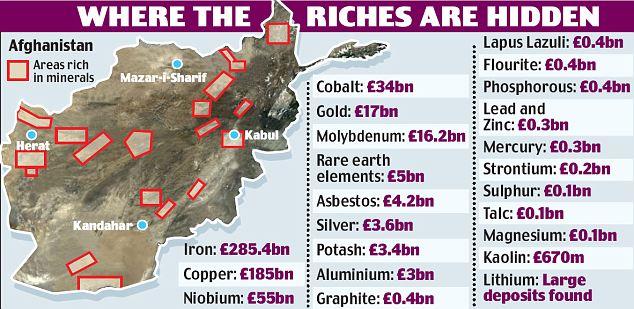Afghanistan is the “the Saudi Arabia of lithium” –a metal that is essential for electric vehicle batteries and battery storage technologies. According to the International Energy Agency these technologies account for 30 percent of the current global demand for lithium. Demand for lithium is projected to increase 40-fold above 2020 levels by 2040, along with rare earth elements, copper, cobalt, and other minerals in which Afghanistan is also naturally rich.
China currently controls the supply chains for most of the production and/or processing of these minerals. Now China may have another source.
According to MarketWatch:
The fall of Afghanistan to the Taliban has led to grave concerns about the safety of Afghan citizens and foreigners alike, but also raised questions about the future of the nation’s vast mineral reserves, once valued at as much as $3 trillion.
The chaos may offer China, which dominates the world market for rare earths, widely used in technology, to step in to develop the mineral reserves, which also include lithium, used in the manufacture of batteries.
“Chinese dealmakers have their bags packed, and will arrive on the first flights after the airports open,” said Byron King, geologist and mining and energy writer for Agora Financial.
In 2010, an internal U.S. Department of Defense memorandum identified the extent of Afghanistan’s mineral wealth at a value between $1 trillion and $3 trillion. In the past, the Afghan government hoped the prospect of lucrative mining contracts would be an enticement for U.S. officials to prolong the American military presence in the country. But, with the Taliban now in charge, that option is no longer available. The Taliban have long illegally tapped the country’s minerals (especially lapis lazuli, a gem) as a source of up to $300 million in annual revenue for their insurgency.

Afghanistan’s mineral wealth would need to be developed and requires physical infrastructure (roads, power plants, railways) to do so, which are not in robust condition given the years of fighting. Massive investments would be needed to develop the resources; China is already planning enormous investments as part of its Belt and Road Initiative. China and Russia are retaining staff in their diplomatic missions in Afghanistan, and will most likely do business with the Taliban. China has already indicated its willingness to recognize a Taliban government.
However, China has had problems in the past investing in Afghanistan. In 2007, China invested $3 billion in a copper mining project in Afghanistan, which failed to produce, largely because of the lack of infrastructure. But, China could benefit from offloading some of the environmental damage that arises from its processing and mining of rare earths and lithium in Afghanistan. In that case, mining would add to other environmental hazards—including water scarcity and air pollution–that the Afghan people face.
China’s Dominance of the Battery Supply Chain
In 2019, Chinese chemical companies accounted for 80 percent of the world’s total output of raw materials for advanced batteries. China controls the processing of almost all of the critical minerals–rare earth, lithium, cobalt, and graphite. Of the 136 lithium-ion battery plants in the pipeline to 2029, 101 are based in China. The largest manufacturer of electric vehicle batteries with a 27.9 percent market share is China’s Contemporary Amperex Technology Co. Ltd. (CATL) founded in 2011.
In addition to rare earths, the manufacturing of lithium-ion batteries depends on key materials like graphite, cobalt, manganese and nickel. In 2019, China produced 64 percent of the world’s graphite, having 24 percent of the world’s reserves.
China has only 1 percent of the world’s cobalt reserves, but it dominates in the processing of raw cobalt. The Democratic Republic of Congo (DRC) is the source of over two-thirds of global cobalt production, but China has over 80 percent control of the cobalt refining industry, where raw material is turned into commercial-grade cobalt metal. Furthermore, China owns eight of the 14 largest cobalt mines in the Democratic Republic of Congo and they account for about half of the country’s output. An American company once owned the largest DRC mine, but sold it in 2016 to China Molybdenum.
China is among the five top countries with the most lithium resources and it has been buying stakes in mining operations in Australia and South America where lithium reserves are located. China’s Tianqi Lithium owns 51 percent of the world’s largest lithium reserve in Australia. In 2018, the company became the second-largest shareholder in Sociedad Química y Minera—the largest lithium producer in Chile. Another Chinese company, Ganfeng Lithium, has a long-term agreement to underwrite all lithium raw materials produced by Australia’s Mount Marion mine—the world’s second-biggest, high-grade lithium reserve.
China mines only 6 percent of the world’s manganese, but refined 93 percent of it in 2019. Most manganese supply is concentrated in South Africa, followed by Australia and Gabon. North America produced zero manganese.
Unlike the other minerals, the nickel mining industry is fairly evenly spread around the world, but China controls 65 percent of the chemical processing. Electric vehicles account for about 7 percent of overall nickel consumption today, but that would skyrocket under plans to electrify vehicles as proposed by Joe Biden.
Conclusion
To have Afghanistan’s minerals under Taliban control is a blow to American economic interests. And, despite the Taliban’s struggle to maintain basic public services and utilities in the cities that they have seized, the opportunity is there for China or Russia to capture some of the country’s mineral wealth. In yet another way, President Biden’s policies will benefit China and Russia while costing the American people.



